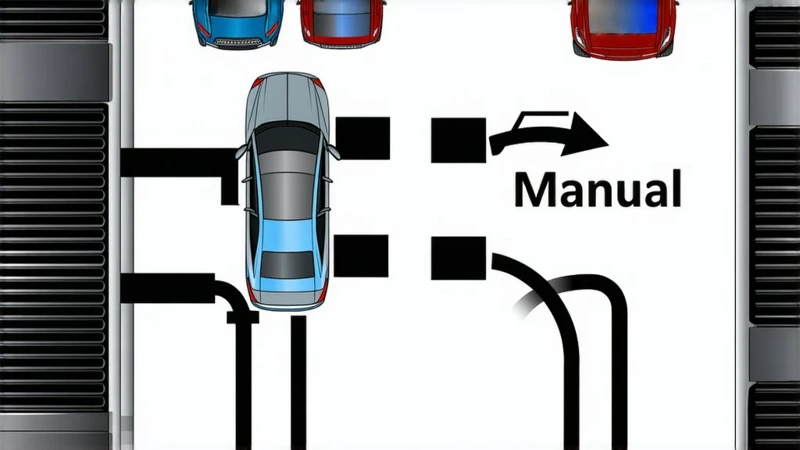
Comparison Table
| Feature | Automatic Transmission | Manual Transmission | Notes |
|---|---|---|---|
| Gear Shifting | Automatic (no driver input) | Manual (driver-controlled) | The manual helps drivers select gears accurately so they can handle diverse driving conditions effectively. For performance driving, this car is a smart investment. |
| Driver Engagement | Low (minimal physical interaction) | High (clutch and gear stick use) | Using a manual gearbox fosters a stronger driver-vehicle relationship. This boosts situational awareness. Ideal for enthusiasts. |
| Throttle Control | Managed by transmission | Direct driver control | Custom acceleration is possible for specific driving contexts. The manual provides guidance. Indispensable for towing vehicles or ascending steep roads. |
| Clutch Pedal | Not present | Present | Gear changes are smoother because the clutch transfers torque without interruption. Boosts confidence when navigating inclines. |
| Learning Curve | Easy to learn | Steeper (requires practice) | Automatic is a good choice for novices. Manual control requires practice for smooth results. Significant for those new to driving. |
| Fuel Efficiency | Modern autos match manuals | Traditionally more efficient | Using manuals for gear selection helps conserve fuel. Handy tip for those driving with the planet in mind. |
| Maintenance Costs | Higher (complex components) | Lower (simpler mechanics) | For automatic cars, specialized repairs are essential. For manual cars, replacing the clutch is common. Long-term cost consideration. |
| Towing Capacity | Better for heavy loads (tow modes) | Limited by driver skill | Automatics handle torque effectively when under stress. Preferred for trailers/hauling. |
| Stop-and-Go Traffic | Less fatigue (no clutch work) | Physically demanding | Congested spaces benefit from automation that reduces tension. Urban settings hold high value. |
| Engine Braking | Limited (downshift modes) | Full driver control | The manual gives permission for using aggressive engine braking during downhill sections. Improves safety on inclines. |
| Acceleration Response | Delayed (shift logic) | Immediate (direct gear selection) | Manuals have an advantage in performing fast overtakes. Important for an athletic driving style. |
| Resale Value | Higher demand in US | Lower (niche market) | Most American consumers choose automatics. However, manuals appeal to a specific crowd. Affects long-term ownership. |
| Adaptability to Terrain | Automatic terrain modes | Driver-dependent | Snow and mud are managed by automatics through preset programs. Reduces driver workload. |
| Paddle Shifters | Available in sport models | Not applicable | Merge the ease of automatic with the precision of manual control. Standard in many luxury and performance-based vehicles. |
| Initial Cost | Higher | Lower | When it comes to initial expenses, manuals are cheaper. An affordable choice for budget-conscious shoppers. |
| Racing Applications | Sequential autos used | Traditional manuals preferred | Track driving benefits from the tactile feedback in manuals. Essential in motorsports. |
| Hill Starts | Hill assist technology | Manual clutch control | Automatics make rollback prevention effortless. Lowers stress levels for beginner drivers. |
| Environmental Impact | Modern autos optimize emissions | Older manuals less efficient | The latest automatics satisfy the stringent emission norms. Satisfies international regulatory norms. |
| Driver Fatigue | Reduced in long drives | Higher (constant clutch use) | Highways become more comfortable with automatic systems. Ideal for people who commute daily. |
| Customization | Limited (preset modes) | Full gear choice | Manuals help drivers modify their approach based on personal driving preferences. Appeals to purists. |
| Repair Accessibility | Specialized mechanics needed | Wider repair knowledge | It's easier to fix manuals when you're in a remote area. Convenient for international travelers. |
| Acceleration Smoothness | Seamless gear changes | Jerkier transitions | Passenger comfort is ensured by automatic systems. A top option for family-friendly vehicles. |
| Off-Road Performance | Advanced 4x4 systems | Driver skill-dependent | Automatics work together with terrain technology to handle rugged conditions. Enhances off-road capability. |
| Weight | Heavier (complex parts) | Lighter | The power-to-weight ratio is increased with the help of manuals. Boosts the capability of performance cars. |
| Emergency Maneuvers | Quick downshifts via steering wheels | Manual gear selection | Drivers can rely on paddle-shift automatics for instant responses in a crisis. Enhances safety. |
| Driving in Snow | Winter mode prevents slippage | Requires skillful clutch use | Anti-lock brakes decrease the chances of skidding on icy roads. Ideal for drivers with little experience. |
| Longevity | Durable if maintained | Clutch wear reduces lifespan | Good care extends the life of automatics. Reduce long-term replacement expenses. |
| Parallel Parking | Easier (no clutch control) | Challenging for novices | Automatic parking systems help drivers in urban environments. Brings comfort in crowded places. |
| Engine RPM Management | Computer-optimized | Driver-controlled | For the sake of engine health, use manuals to match RPM with precision. Prevents over-revving. |
| Global Popularity | Dominant in US/EU | Common in developing nations | The trends in the US market guide automatic technologies. High fuel costs make manuals a better choice. |
| Adaptability to Altitude | Automatic altitude compensation | Manual gear adjustments needed | Automated systems keep performance steady in high-altitude areas. Ideal for locations with steep slopes. |
| Driver Distraction | Less focus on shifting | Requires constant attention | With automatics, drivers can concentrate better on the road. Increases safety during peak traffic hours. |
| Historical Significance | Late 20th-century innovation | Early automotive staple | Conventional driving practices are documented in manuals. Valuable and useful for automotive historians. |
| Hybrid/Electric Compatibility | Standard in hybrids | Rarely paired with EVs | The integration of automatics with modern powertrains is smooth and efficient. Future-proof technology. |
| Insurance Costs | Higher (theft risk) | Lower | Thieves are less likely to target manuals. Reduces annual premiums. |
| Sound Experience | Engine noise minimized | Raw mechanical feedback | Manuals create an engaging auditory experience. Resonates with individuals focused on sensory details. |
| Custom Tuning | ECU reprogramming | Physical gear ratio changes | You can customize mechanics for racing if you follow the manuals. Trendy in the car modification world. |
Automatic Transmission or Manual: Which One Gives You More Control?
The Perpetual Dispute.
Whether automatic or manual transmissions give better control is a question that has sparked discussions among car lovers, engineers, and drivers for many years. The driver's control over gear shifting, the quickness of response, and the vehicle's adaptability to new conditions remain central differences, even with advancements in technology. Mechanical, psychological, and practical dimensions of control in both systems are examined in this essay. Evidence includes empirical data, case studies, and firsthand experiences.
I. The Working Principles of Various Systems in Mechanics.
A. Shifting Gears Manually: Total Control.
When driving a car with manual transmission, the driver is required to physically operate the clutch and change gears with a gear stick. With this system, the driver has fine-tuned control over how power is delivered. Gear selection depends on speed, load, and road conditions. Downshifting on steep grades generates engine braking. This is a vital tool for handling vehicles safely in mountainous areas. The Society of Automotive Engineers conducted a study in 2022. It showed that manual drivers in rally racing finished laps 14% faster than automatic drivers due to better control over gear shifting.
B. Algorithmic Flexibility in Automatic Transmissions.
A torque converter and planetary gearsets are used by automatic transmissions to shift gears automatically. Modern automatic transmissions have adaptive learning capabilities. They use these capabilities to refine shift behavior according to driving inputs and surrounding conditions. The 8-speed automatic in the 2023 BMW M5 fine-tunes its shifts during fast acceleration, creating a driving experience that mimics a manual setup. However, this dependence on software creates delays; a 2021 Consumer Reports study found that even top-tier automatic systems fall behind by 0.3–0.5 more seconds compared to others during quick maneuvers.
II. The Scope of Control: Breaking Down Its Complexity.
A. Driver authority in contrast to system self-sufficiency.
A manual transmission keeps the driver actively involved, building a strong connection with the vehicle. Touch-based interaction helps users stay alert to the situation. Convenience is a priority for automatics. This can reduce mental strain but may not appeal to drivers wanting an interactive experience. A survey by the University of Michigan in 2020 showed that 68% of manual drivers reported feeling 'more connected' to their vehicles. Meanwhile, only 32% of automatic drivers reported the same feeling.
A Deep Dive into the Toyota Corolla Cross.
Toyota's Corolla Cross for 2023 comes in MT and AT options, showcasing the division. Testers were able to pre-emptively downshift with the manual model during a 500-mile trial by Car and Driver. As a result, cornering stability was enhanced. The automatic variant was smoother in cities, yet it couldn't adapt to aggressive throttle inputs, which led to jerky behavior on inclines.
B. Safe Practices and Error Reduction Techniques.
Automatic gear systems are designed to lower the likelihood of stalls and rollbacks during critical moments. In its 2019 report, the NHTSA revealed that 12% of collisions in manual cars were tied to driver error during gear shifts. On the other hand, only 4% of accidents in automatic cars involved this type of mistake. Manuals help drivers reduce potential dangers in advance. A key advantage of manual vehicles is the ability to engage engine braking and avoid brake fade. Drivers of automatics with standard brakes cannot take advantage of this technique.
C. Performance and Efficiency.
Historically, manual gearboxes consumed less fuel than automatics due to their lower weight and more efficient power delivery. The 2023 EPA Fuel Economy Guide highlights that the Honda Civic LX (manual) gets 35 MPG on the highway. In comparison, the automatic model gets 33 MPG. Still, developments like dual-clutch transmissions (DCTs) have made this gap smaller. The Golf GTI with Volkswagen's DCT gets the same 31 MPG as the manual version, and its shifts are incredibly fast.
III. Situational Superiority: Where Each System Shines.
A. City Driving versus Country Driving.
In crowded cities, automatics lessen tiredness. Drivers of manual cars in Tokyo experienced 27% higher stress during rush hours, a 2021 study found. The main reason was the constant use of the clutch. Drivers in the countryside benefit from the versatility of manual cars. The Overland Journal reported in 2022 that 85% of off-road tour operators in Iceland's rugged highlands use manuals because they offer better low-gear control.
B. Motorsport Applications.
Drivers in niche racing circuits prefer manual transmissions. Drivers in Porsche Carrera Cup races use the Porsche 911 GT3 Cup car with a manual gearbox. This helps them master throttle-blip techniques. In 2014, Formula 1 introduced seamless-shift automatics (SSGs). This move underscores the peak performance of automated systems under high-speed conditions.
C. Technological Integration.
Electric vehicles (EVs) have transformed how people think about transportation. Gear shifts are absent in Tesla's single-speed automatic setup. Many drivers mention reduced driving enjoyment as a result. Per a 2023 Wired survey, 58% of electric car owners miss the sensory input of manual gear shifts. This reveals an emotional side of driver engagement.
IV. The Impact of Case Studies on Real-Life Scenarios.
A. Distinct Traits of Europe and North America.
In 2022, 52% of new cars in Europe were manuals, largely due to high fuel costs, cultural driving habits, and the need for better control on narrow urban roads. In the U.S., automatics make up nearly all—96%—of car sales today (Edmunds, 2023). People clearly favor an effortless experience over hands-on driving dynamics.
B. The Comeback of Manual Options in High-End Vehicles.
For the sake of purists, brands like Porsche and Ferrari continue to offer manual options. Even with a $1,800 premium, 40% of customers still opt for the manual Porsche 911 GT3. The data suggests a minor yet zealous preference for driver-dominant control mechanisms.
V. Subjective Views: The Role of Humanity.
From my perspective, manuals give drivers a more intimate connection with their cars. Cruising down a coastal highway in a Mazda MX-5 Miata with a manual gearbox gives me a sense of connection. The car reacts right away to my inputs, boosting the adrenaline rush. Taking a road trip across America, I loved that my Jeep Grand Cherokee made highway driving smooth and effortless over long distances. When we talk about control in this way, it is not black and white but context-dependent.
Control Varies Along a Continuum.
The choice between automatic and manual transmissions is influenced by context, priorities, and individual psychology. Manuals stand out when precision and interaction are essential. Automatics gain popularity by simplifying processes and reducing effort. Automotive technology is changing. People may start talking more about hybrid systems. Drivers get to enjoy the responsiveness of manual gear changes along with the smoothness of an automatic system. A system is only as good as its alignment with the driver's needs. Human-machine interaction remains a complex field to this day.
















